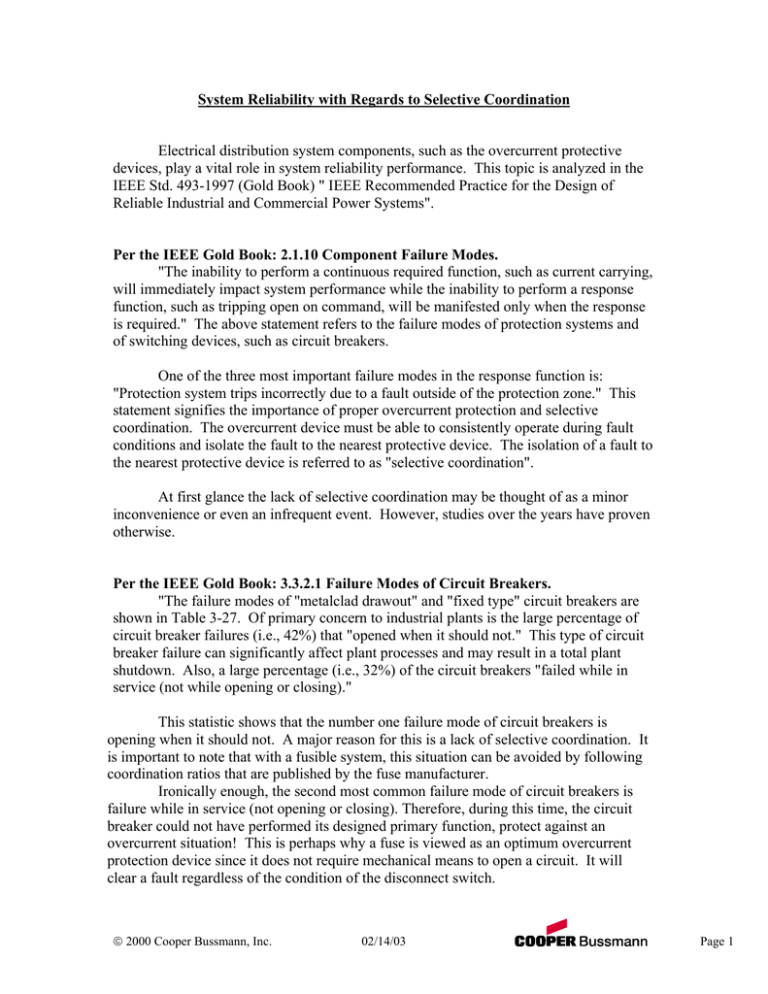System Reliability with Regards to Selective Coordination
advertisement

System Reliability with Regards to Selective Coordination Electrical distribution system components, such as the overcurrent protective devices, play a vital role in system reliability performance. This topic is analyzed in the IEEE Std. 493-1997 (Gold Book) " IEEE Recommended Practice for the Design of Reliable Industrial and Commercial Power Systems". Per the IEEE Gold Book: 2.1.10 Component Failure Modes. "The inability to perform a continuous required function, such as current carrying, will immediately impact system performance while the inability to perform a response function, such as tripping open on command, will be manifested only when the response is required." The above statement refers to the failure modes of protection systems and of switching devices, such as circuit breakers. One of the three most important failure modes in the response function is: "Protection system trips incorrectly due to a fault outside of the protection zone." This statement signifies the importance of proper overcurrent protection and selective coordination. The overcurrent device must be able to consistently operate during fault conditions and isolate the fault to the nearest protective device. The isolation of a fault to the nearest protective device is referred to as "selective coordination". At first glance the lack of selective coordination may be thought of as a minor inconvenience or even an infrequent event. However, studies over the years have proven otherwise. Per the IEEE Gold Book: 3.3.2.1 Failure Modes of Circuit Breakers. "The failure modes of "metalclad drawout" and "fixed type" circuit breakers are shown in Table 3-27. Of primary concern to industrial plants is the large percentage of circuit breaker failures (i.e., 42%) that "opened when it should not." This type of circuit breaker failure can significantly affect plant processes and may result in a total plant shutdown. Also, a large percentage (i.e., 32%) of the circuit breakers "failed while in service (not while opening or closing)." This statistic shows that the number one failure mode of circuit breakers is opening when it should not. A major reason for this is a lack of selective coordination. It is important to note that with a fusible system, this situation can be avoided by following coordination ratios that are published by the fuse manufacturer. Ironically enough, the second most common failure mode of circuit breakers is failure while in service (not opening or closing). Therefore, during this time, the circuit breaker could not have performed its designed primary function, protect against an overcurrent situation! This is perhaps why a fuse is viewed as an optimum overcurrent protection device since it does not require mechanical means to open a circuit. It will clear a fault regardless of the condition of the disconnect switch. 2000 Cooper Bussmann, Inc. 02/14/03 Page 1 It is important to note that the above information is for all circuit breakers. If the information is broken down to 0-600V types, the information is as below. Type Type of Failure Percentage of all Failures Metalclad Drawout Opened when it should not 71 Failed while in service 10 Fixed Type Opened when it should not 5 (includes Molded Case) Failed while in service 77 From the above data, it is clear to see that the metalclad drawout type most often "opened when it should not", probably from a lack of selective coordination or improper trip setting. This is ironic because its primary purpose for use is to achieve selective coordination! To the contrary it had very low "failures in while in service". This is not surprising since the device is able to have maintenance performed on it to assure proper operation while in service. The other failed type (which includes molded case) had a very low "opened when it should not". This is surprising at first since the lack of selective coordination is definitely an issue with molded case types. However, since this is based upon an industrial plant, most upstream devices would be of the metalclad drawout type, thus, those are the ones that would illustrate a lack of coordination. If the upstream device was a molded case circuit breaker in lieu of a metalclad drawout device, it would be expected that the "opened when it should not" would be much higher and similar to the metal clad drawout device. The alarming statistic for molded case breakers is that the "failed while in service" is 77%. Again, this shows the lack of ability of the molded case circuit breaker to perform its primary function, protect against overcurrents. This is not all that surprising since the molded case circuit breaker is typically not able to have maintenance performed on it. Reliability Data - Appendix A: One final consideration is to notice that fuses alone were not analyzed in the IEEE Gold Book. Disconnect switches, however, were analyzed. These were not specified as either fused or non-fused, however, it would be assumed that the majority of these disconnect switches would be fused disconnect switches. Since the disconnect switch is the mechanical device, it most likely would be the cause of a failure, as opposed to the fuse. Thus, it could be assumed that forced outages for fusible systems are typically due to a malfunction of the disconnect switch as opposed to improper operation of the fuse. This would be especially true if the fuse manufacturer coordination charts are used, the fuse is properly sized for the load and the equipment is well maintained. 2000 Cooper Bussmann, Inc. 02/14/03 Page 2 In Appendix A of the IEEE Gold Book, some data can be used to compare the reliability of disconnect switches (assumed fusible) vs. circuit breakers. The data, listed below is based on a 1971-72 study per Table 5 & 9 in Appendix A of the IEEE Gold Book: Plants 16 16 28 Sample Size Industry 15,490 All 9,501 All 40,770 All Device Failure/Unit-Yr Encl. Disc Sw 0.0061 Fixed** - All 0.0052 MCDO*** - All 0.0030 DT*/Failure 2.8 4.0 7.6 *DT = Downtime (Median Plant Avg) **Fixed = Fixed Mounted Circuit Breaker (including molded case) ***MCDO = Metalclad, Drawout Circuit Breaker Analyzing the above data, by multiplying the failure/unit-yr and avg DT/failure, the result is the hour downtime/unit-year. Summarizing the results: Plants 16 16 28 § § Sample Size Industry 15,490 All 9,501 All 40,770 All Device Encl. Disc Sw Fixed* - All MCDO* - All AVG DT/Unit-Yr 0.017 0.021 0.023 Per the above data, fuse switches would be then be an average of: 19% more reliable than fixed mounted circuit breakers (including molded case) 26% more reliable than metalclad drawout circuit breakers Also note that above does not include annual maintenance and testing down time necessary to ensure proper breaker function, which is not required with a Class L, RK1 or J fuse. Since both a fused disconnect switch and circuit breaker are mechanical devices, one possible explanation for the increased reliability with a fused disconnect switch is due to the fuse. This is most likely due to better overcurrent protection and coordination provided by the fuse in comparison to the circuit breaker. In conclusion, based upon the above statistics the IEEE Gold Book reaches the following conclusions: 4.7 Conclusion. "The plant engineer should analyze his or her system electrically and physically and inquire about the utility's system." Two of these concerns are: (1) See that faults are properly isolated and the critical loads are not vulnerable to interruption or delayed repair (2) Develop preventive maintenance, checking, and logging procedures to ensure continuous optimum reliability performance of the plant. 2000 Cooper Bussmann, Inc. 02/14/03 Page 3




